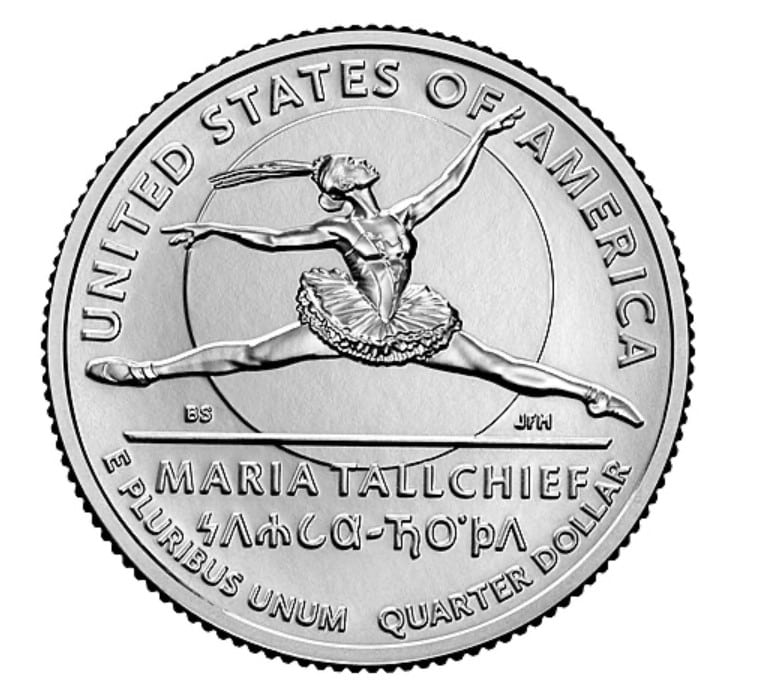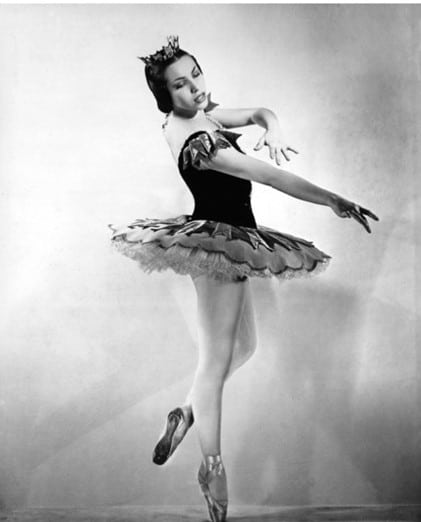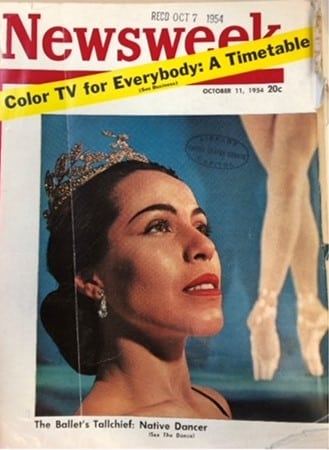She was born on an Indian reservation in the 1920s. Her father was Osage Indian and her mother Scottish-Irish. This little girl, who kept her Native American name, went on to become America’s first major prima ballerina. On Oct. 23, 2023, the United States Mint honored her as the year’s final pick for the American Women Quarter Series.
Elizabeth Maria Tallchief was born on Jan. 24, 1925, in the small town of Fairfax, Oklahoma. She remembers dancing at a very young age despite it being against Indian tradition. Osage women were normally forbidden to dance; however, her parents sensed that their daughter had unique talents and allowed it. They encouraged her to start piano lessons at age three and allowed dance lessons shortly after that.
Betty Marie, or just Maria as she was called, danced in Oklahoma rodeos and other small-town benefits. It was the era of Shirley Temple movies and young girl dance performances were popular. In the early 1930s, her family moved to Los Angeles to further the dancing careers of Maria and her younger sister, Marjorie. It was not an easy adjustment. Maria trained for five years under the famous dancer and artist Bronislava Nijinska and made her debut performance at the Hollywood Bowl at age fifteen.
In high school, Maria continued to practice both piano and dance. But after graduation she made her choice; it would be dance. When she was just seventeen, Maria and a chaperone traveled to New York to follow that dream.
Maria soon became an apprentice dancer for the Ballet Russe de Monte Carlo in New York and was chosen as a replacement dancer for the Paris Opera House. Young Maria, at age twenty, was the first American to perform at that opera house in over 100 years. She later called it one of her greatest thrills. The people of Paris were very taken with this talented, red-skinned young woman.
In 1946, Maria married George Balanchine. He was a choreographer and founder of the New York City Ballet. He made Maria the ballet company’s first star. Balanchine was considered a pioneer in dance and choreography with a style all his own. His style and Maria’s passion for dance made them an amazing artistic team.
Although their marriage ended in 1952, Balanchine and Tallchief remained friends. They maintained a business relationship as dancer and choreographer. Balanchine would later receive a 1983 Presidential Medal of Freedom Award for his achievements.
Maria Tallchief was an active dancer from 1942-1966, a span of over twenty years. Her performance in a classic Russian ballet, “Firebird” (1949), made her an international star. It became Tallchief’s signature role and made her known worldwide. As a result of “Firebird,” Maria traveled extensively and danced for kings, queens, and world leaders. Maria also originated the role of the Sugar Plum Fairy in George Blanchine’s “The Nutcracker.” This ballet is a popular holiday tradition. In 1962, she performed for Presidents Eisenhower and Kennedy during a star-studded gala to raise money for the future Kennedy Center for the Arts.
She was elected Woman of the Year twice by the Washington Press and twice received the Annual Dance Magazine Award. Her home state of Oklahoma declared June 29, 1953, as Maria Tallchief Day in her honor.
Tallchief married twice more and had a daughter, Elise Maria Paschen, born in 1959. Within a year, in 1960, Maria Tallchief was chosen to travel with the American Ballet Theatre’s tour of the USSR. The tour was organized after years of negotiations between the two countries. She was the first American to perform at the Bolshoi Theater in Moscow. After an evening performance, Tallchief and several others were invited to have a midnight supper with Nikita Khrushchev, First Secretary of the Communist Party. That same year, only a month later, Tallchief traveled to London and met with Elizabeth II, Queen of England.
In 1966, Maria stepped down from dance and announced her retirement. It seemed to surprise everyone but herself. It was time to be with family, especially seven-year-old Elise. Maria, at age 41, had been dancing for over twenty years. That was a very long time for ballet. Thirty years after stepping down, she received a lifetime achievement award at the 19th annual Kennedy Center Honors in 1996.
Following retirement, Maria accepted the role of director of ballet for the Lyric Opera of Chicago. From 1981-1987, she became the founder and artistic director of the Chicago City Ballet. In the 1970s and 1980s, she was interviewed several times on television and asked about her career. She would often comment that it took hard work but also a bit of luck. She just happened to be at the right place at the right time. She knew how to take advantage of an opportune moment.
In December 2012, Maria broke her hip. She passed away less than six months later, on April 11, 2013, from complications of this injury. She is buried in Fairfax Cemetery in her home state of Oklahoma.
Tallchief has been called regal, passionate, distinguished, and extraordinary. She is one of five Native American dancers from Oklahoma born in the 1920s. The dancers are honored together by Mike Larsen’s mural “Flight of Spirit.” which is on permanent display at the Oklahoma State Capitol. They are also honored in a group of bronze statues called the Five Moons in the Vintage Gardens of Tulsa, Oklahoma.
Tallchief spent much of her life overcoming discrimination to become a prima ballerina and was proud of her Osage heritage. She wanted this culture passed on. Today there is a non-profit dance school, Dance Maker Academy, operating in Oklahoma. Their goal is to help little girls like Maria Tallchief achieve their dreams.



